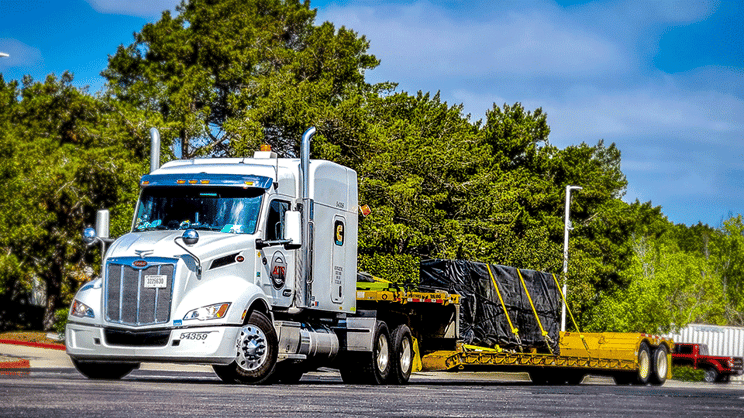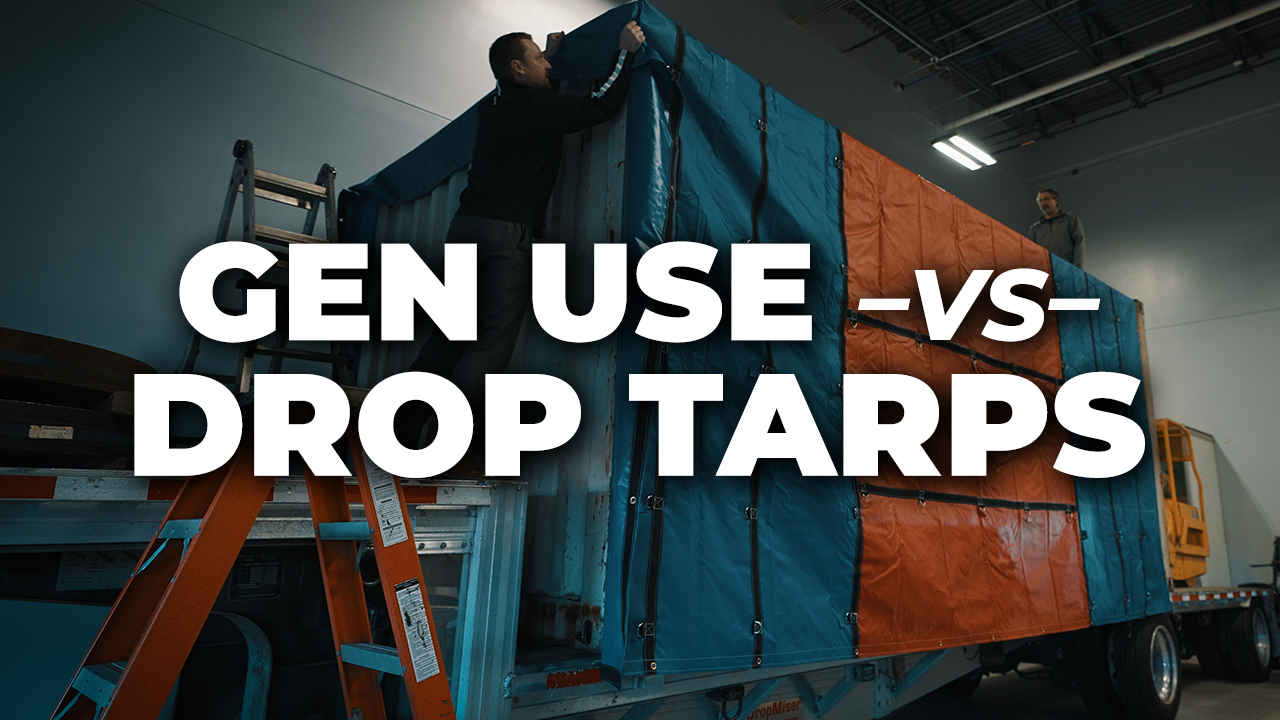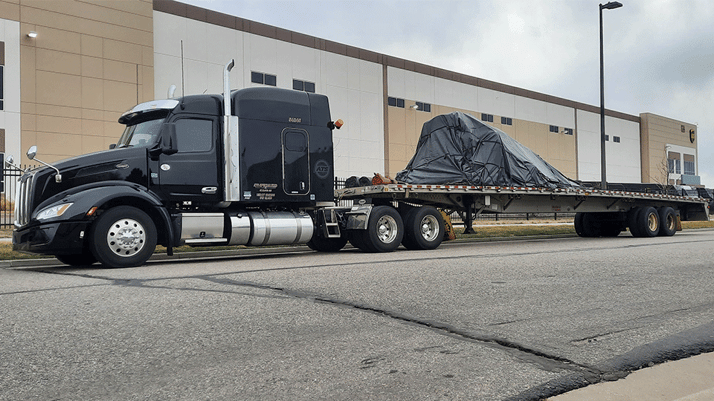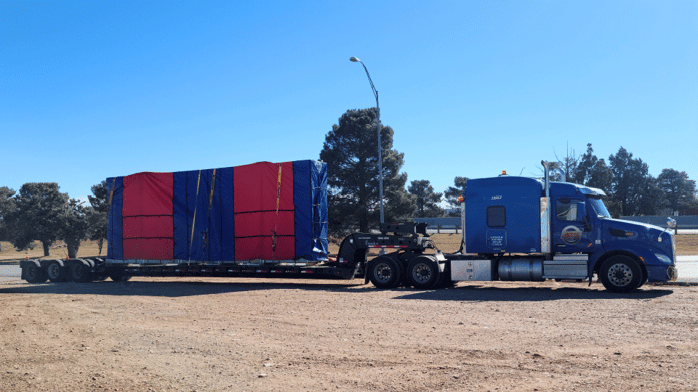
Companies that ship freight using open-deck trailers are no stranger to the realities of doing so. The impact natural elements (wind, snow, rain, etc.) can have on the products transported on open-deck trailers is among the harshest of these realities.
On their own, flatbed, step-deck, double drop and hot shot trailers (to name a few) offer freight zero protection from rain, snow, wind and debris. Unfortunately, it’s not uncommon for some cargoes to arrive at a destination damaged due to prolonged in-transit exposure.
It’s important that your freight always arrives on time and damage-free. Although by their very nature open-deck trailers make this difficult, there are some ways to keep cargo safe and sound from A to B.
Tarping freight at its origin is the most common method companies use to keep their products in good condition during transport. This is likely a great solution for your business as well. So, if you have questions about what tarping your cargo will mean for you and how to ensure success throughout this process, you’re in the right place.
Here at Anderson Trucking Service (ATS), we started moving open-deck freight in 1955 and haven’t looked back. Today, our fleet of specialized open-deck trailers is utilized by companies across industries to get even the most delicate cargoes where they need to go.
Every truck driver in our fleet carries a set of tarps with them (three general-use/steel tarps, one smoke tarp). However, without knowing what size tarps they need, sometimes shippers are left without a viable solution when the time comes for their cargo to hit the road.
This article will give you the information needed to avoid these issues on your own load as we’ve broken down everything you need to know about arranging your next open-deck shipment (with tarps) including:
- What types of tarps do truck drivers carry?
- How many tarps do must truck drivers carry?
- How much does it cost to tarp a shipment?
- How to make sure your truck driver has the tarps you’ll need.
What Types of Tarps Do Truck Drivers Carry?
There are two common types of tarps in the trucking industry: Drop tarps and steel tarps.

What Are Drop Tarps?
Most truck drivers carry a pair of drop tarps with them. Drop tarps range in size. You’ll see truck drivers carry either 4-foot drop tarps, 6-foot drop tarps or 8-foot drop tarps most commonly. These tarps are usually 20 feet to 24 feet long, 8 feet to 8 feet, 6 inches wide and have an additional hanging flap on each side.
The length of these side flaps will depend on the size of the “drop” on the drop tarp (4-foot drop tarps have 4-foot hanging flaps, 6-foot drop tarps have 6-foot hanging flaps, etc.).
The exact size of tarps a driver carries will depend on the type of freight they are moving or move most typically. It’s not uncommon for a flatbed driver to carry 4- or 6-foot drop tarps as this covers the majority of the freight they’re moving. That said, more specialized open-deck drivers — like those pulling a step-deck or RGN trailer — may carry 8- or 10-foot drop tarps.

What Are Steel Tarps?
Steel tarps are rectangular in shape and do not have drops on either side. When using a steel tarp, the center of the tarp is placed over the freight, draped over the sides and secured at the bottom. Excess tarp, if any, is folded under the freight.
In addition to standard square or rectangular freight, steel tarps can be rotated to cover oddly shaped loads. These rectangular tarps can overlap at the top of the freight to make sure the entire length of the load is covered.
Drivers who carry steel tarps may carry several sizes, often 20 feet by 20 feet or 20 feet by 26 feet. This is large enough to cover legal loads. Drivers who carry over-dimensional freight will use multiple tarps to fully cover it as needed.
Heavy-duty steel or drop tarps are heavy — most weigh around 100 pounds. While it may be tempting for the driver to use one large tarp, using multiple smaller tarps makes it easier and safer to maneuver the tarp and cover the freight.
How Many Tarps Do Most Truck Drivers Carry?
Truck drivers usually carry two drop tarps of the same size. In most cases, this is enough to completely cover the cargo being moved. As long as a carrier is aware of the dimensions they will need to cover, two adequately sized tarps give them the ability to overlap them and make adjustments to their alignment as necessary (as a visual, think of stitching together a quilt).
With the freight covered, drivers then secure their tarps using bungee cords, rope and/or straps. Since any extra tarp material can be bunched up, there’s no need to acutely customize the tarp size used for the cargo being covered.
No matter which type of tarp you use, tarping is a physical, potentially dangerous job. Transportation carriers charge a premium for this service.
How Much Will You Pay to Tarp Your Shipment?
Expect to pay between $50-$150 to have your cargo tarped. The exact price you pay to have a shipment tarped will depend on your situation. Since tarps are a heavy piece of equipment and take drivers quite a bit of effort to apply, throwing tarps outside in the dead of winter or in the summer heat may cost more than if you allow a driver to throw them inside.
Additionally, applying larger tarps, which can be more time-consuming, will also cost more — plan to pay a bit more to have larger cargo tarped.
How Much Does an Over-Dimensional Tarp Charge Cost?
If your freight exceeds legal dimensions in either length, width or height (or a combination thereof) you will need to pay an over-dimensional tarp charge. As freight gets larger, tarping it gets harder and more time-consuming — raising the cost of this service. Beyond this, oversized tarps are more expensive to purchase and fewer carriers keep them on hand. This also impacts the price.
As such, expect to pay $200-$300 for tarps on oversized shipments.
How Much Does a Heavy Haul Tarp Charge Cost?
Tarping a heavy haul shipment will usually cost up to $750 or more as drivers dedicate additional time to this process and use more specialized tarps. Although whether your freight qualifies as "heavy haul" will vary by provider, expect to pay for heavy haul tarps when your shipment exceeds 14 feet, 6 inches wide, 14 feet, 6 inches high or 100 feet long.
Secure the Tarps You Need by Prioritizing Communication
To ensure that your transportation solution shows up with the right number and size of tarps for your freight, it will be important to clearly communicate what your freight is.
Make sure to talk to your carrier(s) and relay information like:
- What specific kind of cargo needs to be moved
- What the overall dimensions are (height, width, weight, length)
- Any trailer type preferences you have
- Whether there are any sharp corners or extra sensitive areas to note
With this information, a good transportation provider will make sure the truck, and driver, they send to your door are properly equipped to meet your needs.

But Wait: Is Tarping Actually Your Best Option?
Now that you understand the common tarp sizes and quantities carried by open-deck truck drivers you’re better prepared if your load requires tarps in the future.
That said, tarping your open-deck cargo isn’t the only way to keep these items safe during transport. In fact, using a Conestoga trailer can actually be a better solution in some scenarios.
Conestogas provide excellent protection from the elements and offer freight a touch-free experience (tarps typically rub against products during transport). In the end, these trailers help companies cut out the instances of cargo damage caused by tarps.
Intrigued?
Finally, if you have any questions about the kinds of tarps we use at ATS or how our fleet of open-deck trucks, trailers and drivers can help you meet your deadlines and goals, contact us here. We have a transportation expert standing by to help you in any way you need.




